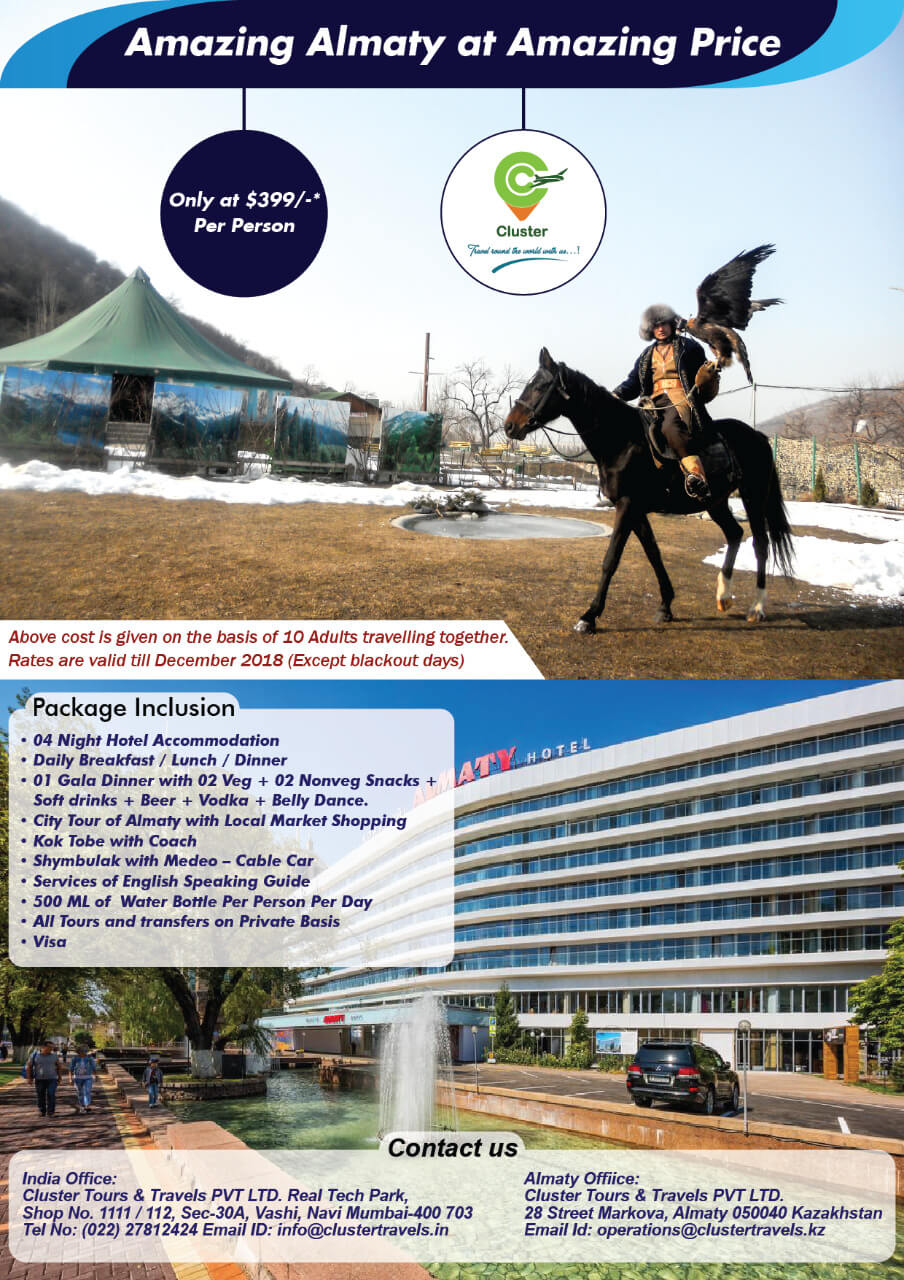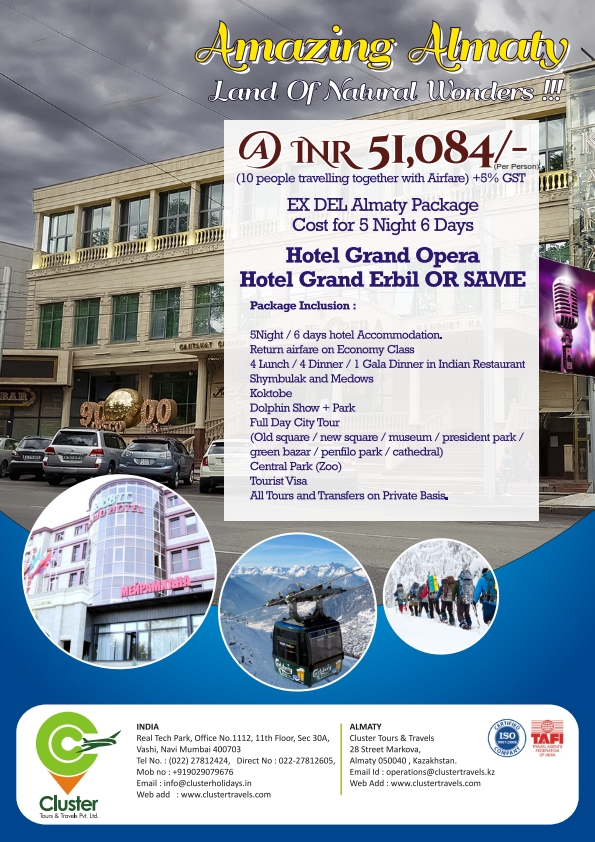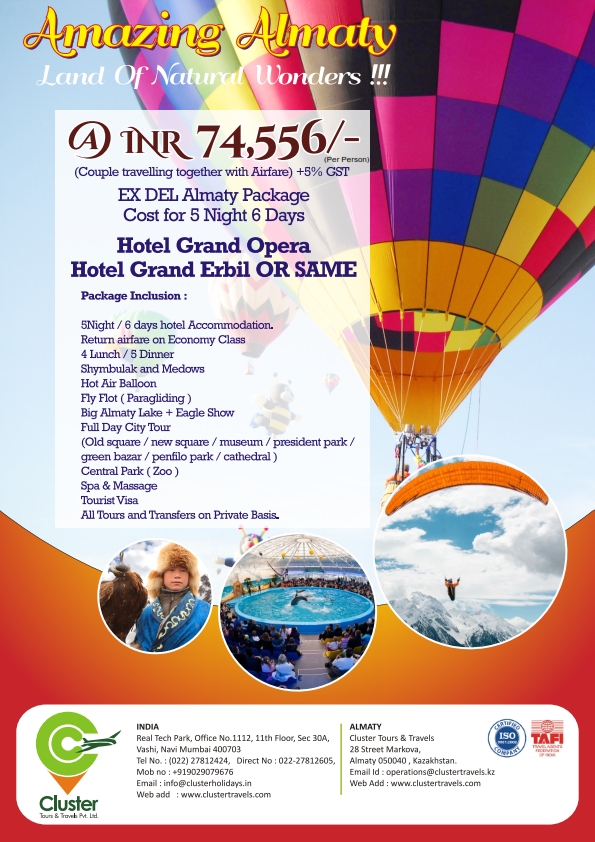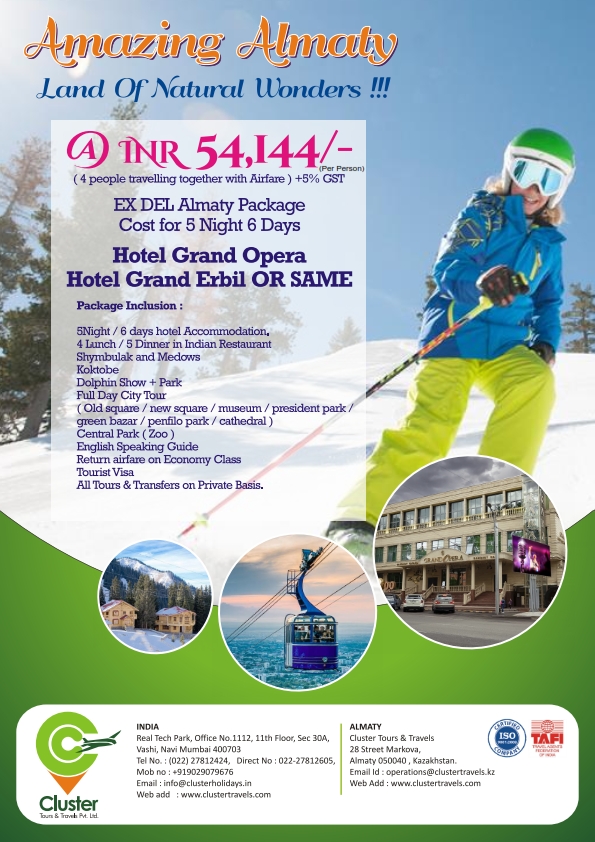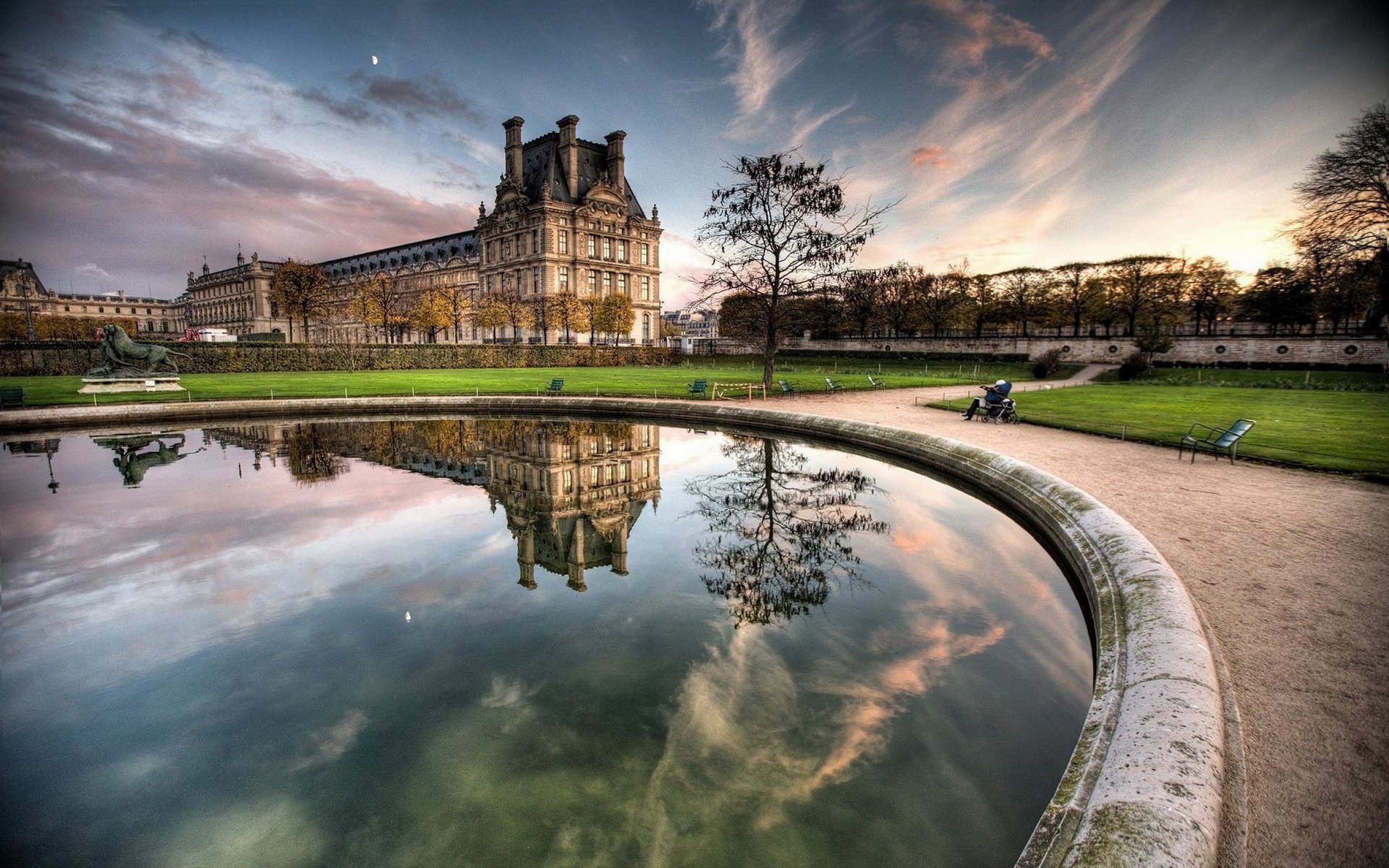


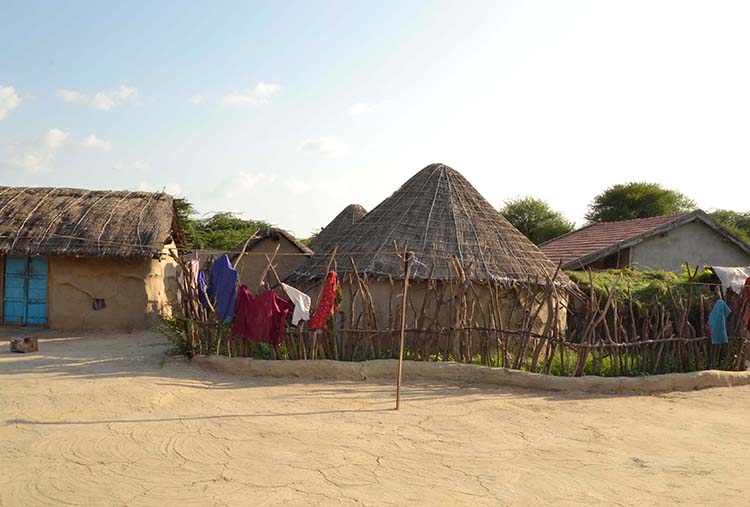
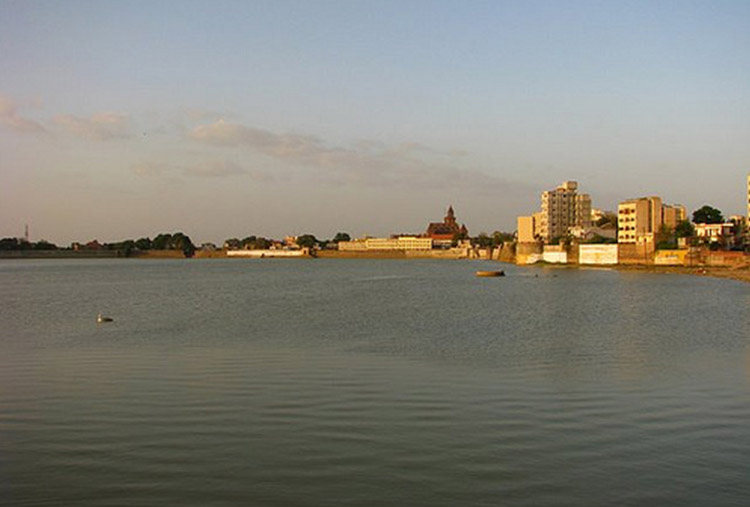
DAY 01 – BY ROAD – 425 KMS / 08 HRS – AHMEDABAD TO BHUJ
Arrive Ahmedabad and drive to Bhuj; Arrive Bhuj and transfer to your hotel.
The historic city of Bhuj derives its name from the Bhujiyo Dungar, a hill, overlooking the present day Bhuj town. Bhuj is a typical example of a desert town located between two geographical features – Bhujiyo Dungar on the east & Hamirsar Lake on the west. Bhuj, the major town of Kutch, is an old city established in 1510. With its surrounding wall, the atmospheric bazaar area, crenelated gateways, old palaces and striking temples the town still retains a medieval character. Every Feb/Mar it hosts the annual Rann Utsav festival.
Overnight at hotel
DAY 02 – IN BHUJ
After breakfast visit the villages of Bhuj. Amidst the Desert land of infinite dimensions, are suspended, quaint little villages. These are the last villages on the India-Pakistan border. Here you will come across master craft people’ exposing their traditional art, turning our master pieces every day. Their ornaments, clothes, utensils, everything they use – will make you feel as if you have stepped into lifestyle museum leaving you spellbound.
Visit the villages of Bhirandiyara: Bhirandiyara is a favourite Tea stop for locals and visitors alike on the road to Khavda. The village boasts of a delicious sweet – fresh Maavo. This milk-based sweet is best when eaten hot. Most of the roadside stalls sell Maavo. The local Meghwal Community has exquisite embroideries and skilfully decorated, colourful Mud Bhungas. Mud-Mirror work – Lippan kam is a decorative art done by common people mainly women. Lippan kam is done inside Bhungas / mud huts in villages of Kutch; sometimes you can find it on outer walls too. Generally, women make birds, trees, animals, and peacock, human figures etc in Lippan kam. It is done with a mixture of clay and camel dung. Then gum is used to stick mirrors. Originality of lippan kam lies in adding no colour or only whites. Small round, diamond-shaped or triangle mirror pieces are essential to lippan kam.
Nirona: The village of Nirona is the only place in the world where the tradition of Rogan art is still practiced (a method of producing dyes from natural resources and castor oil and creating intricate and long-lasting designs on silk and cotton). Rogan art is a rare craft that is not well known even in India. Because of its rare qualities, its practiced by only one family in India and they reside in Nirona village in Gujarat.
Nirona also offers the chance to see artisans making copper bells. The Luhars in Nirona have been preserving the craft of making copper bells over seven generations. The art form originally comes from Sindh and some sister villages in Pakistan too make similar bells but with carvings on the surface.
Another family in Nirona is practicing wood lacquering. Raw lacquer in various colours that is passed with great skill on the wooden object of focus in beautiful waves. The work they do is mainly focused on household items like jewellery boxes and kitchen utensils and has known to last more than 30-35 years. If the lacquer work starts to lose its sheen, just apply some oil on it,
Khavda (90 Km. Approx.) – a town of Pachcham Region. One can find a tiny market and a few stalls serving up Kutchi snacks & tea. One can visit to Khatrivas to see artisans printing & selling Ajrakh. The town also has skilled Leather Craftsmen and there are some shops retailing local crafts, including Leather Slippers. Off the main road is a clinic run by Kutch Mahila Vikas Sangathan (KMVS), Federation of Kutchi Women’s groups. KMVS has trained local midwives in modern and locally suitable healthcare practices. The KMVS Office in Khavda is run almost entirely by local women and has a small retail outlet selling wonderfully intricate embroideries under the producer group’s brand name “QASAB” which means “Craft Skill”.
Ludiya: Ludiya Village is comprised of several hamlets belonging to the Meghwal & Samma Communities. The latter community, primarily herdsmen, is more conservative when it comes to tourists. Gandhi nu Gam, populated by the Meghwal community, features beautifully Painted Bhungas. The Kanjari (Blouses) of the women and the Bhunga decoration of this village are especially colourful. To curb exploitation & experiment with community marketing, the hamlet has set up an “Otlo” or a roofed platform next to the Temple, where each household brings out their embroidered goods for selling.
Dhordo: Dhordo village has been situated as a last village in the area. Dhordo, has had approx.70houses, having 450 odd population of communities of Mutva (90%), Sheikh (8%), and Harijan (2%) involved in doing the jobs of various handicrafts popularly well known as ‘Banni Handicrafts ’which have become famous world across. Here the minutest of minute and expensive embroideries and mud work are done. Their craftsmanship and artistic works are so much excellent that craftsmen/artists have been honoured by national awards. These people subsist and depend mainly on doing mud works, godadi works (very small quilts), patch – works, handmade embroideries as craftsmen and others on livestock as pastoralists (Maldharis).
Inspite of being a last remote village in the Banni area, Dhordo has assumed the status of high – tech village, having the facilities of ATM being run on solar system, a higher secondary school with latest computers. Thus, Dhordo stands out as a model village in Kutch, attracting the industry like Bromine industry and tourism. A solar plant covering the whole village for adequate power – supply for it has been installed. Not only this but as for the water – supply particularly the drinking water, it has been managed by the filtration of the collected water of the pond, which is maintained and becomes useful in the critical situation of shortage of water in summer.
Overnight at hotel
DAY 03 – BY ROAD – 340 KMS / 07 HRS – BHUJ TO JAMNAGAR
After breakfast drive to Jamnagar; Arrive Jamnagar and transfer to your hotel.
Jamnagar or the city of Jams was one of the most important princely states of Saurashtra. Today, the 200km long Jamnagar coast is dotted with several industries run by corporate giants in the region. Jamnagar itself is a centre for the brass industry, bandhani fabrics and zari work. But it’s the princely past that attracts visitors-the Pratap Vilas Palace in a renaissance style, the 16th century Darbargarh Palace with a festival of stone sculptures, the impressive Willingdon Crescent, the museum at Lakota Island Palace of Jamsa-rovar Lake and statues of famous cricketing prince Ranjit Sinhji. Also, worth seeing are the Maqbaras, the colorful sculpture of Sonapuri and the Jain temples in the city centre. Later Visit Bala Hanuman Temple: Bala Hanuman Temple is a pilgrim place venerated by the devotees of Lord Rama. It is a world-famous temple, known for the continuous chanting of Jai Ram, Shri Ram. The chanting is going on since 1964 and has found a place for it in the Guinness Book of World Records. People chant the name of the Lord in shifts, 24hours a day
Overnight at hotel
DAY 04 – BY ROAD – 145 KMS / 03 HRS – JAMNAGAR TO DWARKA
After breakfast drive to Dwarka; Arrive Dwarka and transfer to your hotel.
The small coastal town of Dwarka is one of the four most holy Hindu pilgrimage sites in India. It is here that Krishna founded his capital after leaving Mathura. Excavations have revealed 5 earlier cities at the site, all submerged. The present town dates largely to the 19th century and attracts thousands of pilgrims to celebrate the Holi, Diwali and Janmashthami festivals. The multi pillared Sabha Mandapa leads to a 60-pillared sanctum sanctorum that dates back 2500 years as per to the scriptures.
Later visit Bet Dwarka, Nageshwar Temple, Rukmani Temple and Gomati Talav. The visit of Dwarka is not complete without a visit to Bet Dwarka, an island at 30 Kms. Off the coast of Okha port, At Bet, there are temples of Vishnu (in the form of ‘matsya’), Radha, Lakshmi, Satyabhama, Jambuvanti and Devaki. A ferry ride from Dwarka to the island of Bet near Okha makes a pleasant outing. Nageshwar temple is situated towards Okha dedicated to Lord Shiva and houses one of the 12 Jyotirlingas in an underground chamber. Then visit Gomati Village, Gomati Talav and Gomati Mandir.
Overnight at hotel
DAY 05 – BY ROAD – 250 KMS / 05 HRS – DWARKA TO SOMNATH
Early morning visits the Dwarkadhish Temple and witness the Aarti.
After breakfast drive to drive to Somnath enroute visiting Porbandar.
Porbandar, the coastal heritage town of Gujarat is located on the Saurashtra peninsula, on the Arabian Sea. This city is described in Skanda Purana as Sudamapuri and Ashmavati and had a flourishing trade with Africa and Arabia. As per the legends, this city was the main link of the great friendship between Lord Krishna and Sudama. Porbandar was established as a capital by Rana Sartanji in 1785 AD. Porbandar was the former capital of the Jethwa Rajput petty princely state. The most impressive feature of Porbandar is the city planning and the stone buildings with ashlar masonry and rich carving, the facades of the houses on either side of the streets, with windows and carved gateways. Porbandar is also associated with Mahatma Gandhi, the father of nation as he was born here. Today, fine quality silk and cotton are manufactured here. There are also chemical factories and cement works.
Later visit Kirti Mandir – Kirti Mandir was the house of the Mahatma Gandhi and Kasturba, his wife. This place is situated near the place where the Mahatma Gandhi was born. This place is now a small museum and has a Gandhian library and a prayer hall.
Later continue to drive to Somnath; arrive Somnath and transfer to your hotel.
Somnath consists of a few streets leading away from its phoenix like temple. The rugged sea below gives it a lonely, wistful charm. The pilgrim trade is constant, but merchants are relaxed, perhaps in deference to the shadows cast by the awe-inspiring temple. Somnath is mainly known for the legendary shore temple of Somnath, which is dedicated to the Lord Shiva.
The legendary shore temple of Somnath is one of the twelve most sacred shrines dedicated to the Lord Shiva. The temple contains the Jyotirlinga of Lord Shiva. As per the legends, the Somnath temple is very old and was originally built in gold by the Somraj, the Moon God. Later, it was rebuilt by Ravana, in silver; then by Krishna in wood and Bhim Dev in stone. Mahmud of Ghazni, upon hearing the description of the richness of the Somnath temple by Al Biruni, an Arab traveller, visited this temple in 1024 AD. At that time, this temple had about 300 musicians, 500 dancing girls and 300 barbers to shave off the heads of pilgrims. After a two-day’s battle, Mahmud destroyed the temple and carried away jewels and gold to his homeland. In all, the Somnath temple was rebuilt and destroyed eight times. This temple was finally rebuilt in 1950 with the support of Sardar Vallabhabhai Patel. The current temple was built as per the traditional designs on the original site by the sea and is a serene, symmetrical and sinuous structure. Today, this majestic temple is a replica of the earlier temple.
Later visit Rudreshvara Temple – Rudreshvara Temple is a ruined temple located near the Somnath temple. Bhalka Tirth – Bhalka Tirth is situated halfway between the Veraval and Somnath. At this place, the Lord Krishna was mistaken for a deer and wounded by an arrow.
Overnight at hotel
DAY 06 – BY ROAD – 100 KMS / 02 HRS – SOMNATH TO DIU
After breakfast drive to Diu; Arrive Diu and transfer to your hotel.
A beautiful blend of sun, sand and sea, Diu is a God’s gift to those in quest of a blessed land where the weary weight of this unintelligible world can, for a while, be lightened and the waking soul can hear the music of the nature. This tiny island of breeze, beauty and serenity situated off the southern tip of the Saurashtra (Kathiawad) peninsula of Gujarat, lapped by the Arabian Sea, is a picture of calmness with superb beaches and fascinating history.
St. Paul’s church: The Church adorned with curiously treated volutes & shell-like motifs and the magnificent wood carving is the most elaborate of all the Portuguese churches in India.
St. Thomas Church Museum: A huge edifice in gothic architecture was built in 1598. A part of it has been converted into a museum an Archaeological treasure house.
Diu Fort: This majestic structure stands on the coast of Diu sentinel. Once inside, you are overwhelmed by the gaunt majesty of the ancient stone work which transports you to a bygone era of gallant soldiers where time stands still.
Nagoa beach: The Nagoa beach is exceptionally beautiful & quiet. In the exceptionally beautiful horse-shoe (semi-circular) shaped beach.
Overnight at hotel
DAY 07 – IN DIU
Day is at leisure.
Overnight at hotel
DAY 08 – BY ROAD – 120 KMS / 02 HRS – DIU TO SASANGIR
After breakfast drive to Sasan Gir, popularly known as Gir, the most famous loin sanctuary in India. And the one place in the subcontinent where Asiatic Loins can be found in the wild. Sasan Gir on the south-western border of Saurashtra peninsula in Gujarat and is home to nearly 400 Asiatic loins. The Sanctuary was created in 1913 to provide protections to the largest surviving groups of the Asiatic loins and was given the status of the sanctuary in 1965; the numbers of loins has been steadily on the rise since 1980.This is the only place in the World outside the African continent where the loin can be seen in its natural habitat. The loin safaris are popular among tourist & jeep are freely available for touring the forest. Though the most famous inhabitants of the park are Asiatic loins but it is also providing natural habitat to lot of species like chital, Chinkara (Gazelle) four horned antelope. Leopard, Nilgai, spotted deer, wild boar, wild ass, monkeys, parrots and peacocks, many others birds etc.
Overnight at hotel
DAY 09 – BY ROAD – 375 KMS / 07 HRS – SASANGIR TO AHMEDABAD
After breakfast drive to Ahmedabad; Arrive Ahmedabad and transfer to your hotel.
Ahmedabad is Located on the banks of the river Sabarmati; the city was founded by Sultan Ahmad Shah in 1411. Today it is one of the fastest growing cities of India and is an immense repository of tradition, history & culture. Its famous walled area is one of the finest examples of community living & the city thrived as the textile capital & was nicknamed “Manchester of the East’ in 1888. This multicultural city is home to some of the finest Indo-Sarcenic mosques & Jain temples.
The old city of Ahmedabad is dotted with labyrinthine by lanes called ‘polls’. The exquisite carved wooden mansions and havelis are in no manner less than their stone counterparts in Rajasthan. The city also offers a rich architectural legacy that blends Hindu and Muslim schools of architecture, stone and brick with arches, domes and vaults, carved pillars, trefoil designs besides the modern buildings designed by the famous French architect, Le Corbusier and Louis Kahn.
Overnight at hotel
DAY 10 – IN AHMEDABAD
After breakfast proceed for city tour of Ahmedabad.
Gandhi Ashram: On a quite peaceful stretch of the Sabarmati River, Mahatma Gandhi set up a simple retreat in 1915. This was his Satyagrah Ashram and for many years it was the nerve centre of India’s freedom movement. It was from here, in 1930, that Mahatma began his famous Dandi March to the sea to protest the Salt Tax imposed by the British. Hridaya Kunj, the simple cottage where he lived, is now a national monument and preserved as it was during the Mahatma’s life-time.
Sidi Sayed Mosque: One part of the wall in the old citadel of the mosque built by Ahmed Shah’s slave, Sidi Sayed, is celebrated the world over for its exquisite stone window tracery – a superb & peerless example of delicate carving that transforms stone into filigree.
Jumma Masjid: The Friday mosque was built by the city’s founder, Sultan Ahmed Shah, in 1423. Built of yellow sandstone in an architectural style that combines the best of Muslim & Hindu traditions. It stands on 260 pillars that support 15 domes at varying elevations.
Teen Darwaja: The triple-arched gateway was built by Sultan Ahmed Shah to serve as the royal entrance to the Maidan Shahi or the Royal Square. It is in an imposing monument of perfect proportions & highly ornate buttresses.
Hutheesingh Jain Temple: Built outside the Delhi Gate in 1850 by a rich Jain merchant, the Hutheesingh Temple is the best known of Ahmedabad’s many ornate Jain temples.
Adalaj Step-well: It is situated 17kms north of Ahmedabad. The step well at the village of Adalaj is another fine example of this magnificent architectural form. Adalaj Vav is richly carved, every pillar and wall surface covered with leaves and flowers, birds and fishes and friezes of ornamental designs.
Akshardham: Lord Swaminarayan, born in Chapaya in Uttar Pradesh, took a seven-year pilgrimage in Gujarat to preach his religion. He built six temples, the first being at Kalupur in Ahmedabad. Akshardham, the Swaminarayan temple of Gandhinagar, is a modern complex, built in traditional Indian architectural style from 6,000 metric tons of pink Rajasthan sandstone, carved by expert artisans from Bansipahadpur. The temple is set in a multi-acre garden called Sahajanand Van, with intricate sculptures of Hindu Gods. There is a gold leaf copper sculpture of Lord Swaminarayan that faces similar sculptures of Gunatinand Swami. The interiors have beautiful columns in rosewood that rise to a high dome. Akshardham remains closed on Mondays.
Overnight at hotel
DAY 11 – BY AIR / TRAIN – DEPART AHMEDABAD
Today in time transfer to Ahmedabad Airport / Railway Station to board flight / train for your next destination
Hotels Accommodation
Mail as per Itinerary
Economy Air Ticket
Tourist VISA
Travel Insurance
There is no content
1) Ahmedabad, in western India, is the largest city in the state of Gujarat. The Sabarmati River runs through its center. On the western bank is the Gandhi Ashram at Sabarmati, which displays the spiritual leader’s living quarters and artifacts. Across the river, the Calico Museum of Textiles, once a cloth merchant’s mansion, has a significant collection of antique and modern fabrics.
2) Bhuj is a city in the state of Gujarat, western India. It’s known for its centuries-old buildings, many of which were damaged in a 2001 earthquake. Close to Harmirsar Lake, the 18th-century Aina Mahal palace is elaborately decorated with chandeliers, mirrors and semi-precious stones. Nearby, the Italian Gothic–style Prag Mahal palace has a bell tower that overlooks the city, and a courtyard containing a Hindu temple.
3) Jamnagar is a city located on the western coast of India in the state of Gujarat in Saurashtra. It is the administrative headquarters of the Jamnagar District.
4) Dwarka is an ancient city in the northwestern Indian state of Gujarat. It’s known as a Hindu pilgrimage site. The ancient Dwarkadhish Temple has an elaborately tiered main shrine, a carved entrance and a black-marble idol of Lord Krishna. Dwarka Beach and nearby Dwarka Lighthouse offer views of the Arabian Sea. Southeast, Gaga Wildlife Sanctuary protects migratory birds and endangered species like the Indian wolf.
5) The Somnath temple located in Prabhas Patan near Veraval in Saurashtra on the western coast of Gujarat, is believed to be the first among the twelve jyotirlinga shrines of Shiva. It is an important pilgrimage and tourist spot of Gujarat.
6) Diu is a coastal town at the eastern end of Diu Island, India. A bridge connects the island to the state of Gujarat. Overlooking the Arabian Sea, Diu Fort, a 16th-century Portuguese citadel, features a lighthouse and cannons. Inland, centuries-old St. Paul’s Church was built in elaborate baroque style. Nearby, whitewashed St. Thomas Church is now home to the Diu Museum, with wooden carvings and religious artifacts.
7) Sahibzada Ajit Singh Nagar district, also known as Ajitgarh district, is one of the twenty two districts of Punjab a state in north-west India. It was formed in April 2006 and is 18th district of Punjab, created next to Pathankot district.
Special Offers
